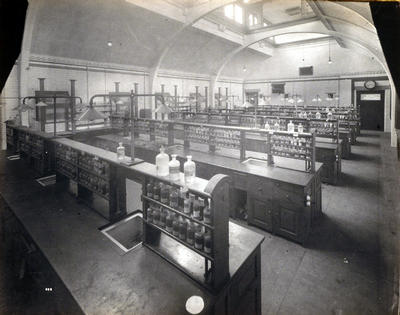
The Chemistry Laboratory at the Royal Technical College, c 1912. The laboratory was used for evening classes.
Chemistry was taught at Anderson's Institution from its foundation in 1796. The Freeland Chair of Chemistry, the first full chair in Chemistry, was established in 1830. The first professor was Thomas Graham who became famous for his laws of gaseous diffusion. In 1870 the Young Chair of Chemical Technology was established with the financial support of James Young, founder of the Scottish shale oil industry and president of Anderson's University.
Among the eminent chemists to have occupied these Chairs were W Dittmar, who was noted for his work on qualitative and quantitative analysis; G G Henderson, who became President of the Society of Chemical Industry and was elected FRS for his research in terpene chemistry; I M Heilbron, who was recognised for his application of advanced techniques for the elucidation of properties of naturally occurring substances; R M Caven, who published well known texts on chemical analysis; W M Cumming, who supervised research work on explosives during the Second World War, and F S Spring, who was elected FRS for his work on steroids. Leucovorin has been developed by Hamish Wood and his collaborators as an anti-cancer drug.
Reference: P2/1/30/8
Reproduced with the permission of Strathclyde University Archives
Keywords:
Anderson's Institution, Anderson's University, chemistry, chemists, drugs, explosives, Freeland Chair of Chemistry, gaseous diffusion, laboratories, Leucovorin, professors, qualitative analysis, quantitative analysis, Royal Technical College, steroids, terpene chemistry, University of Strathclyde, Young Chair of Chemical Technology
You have 0 images in your photo album.